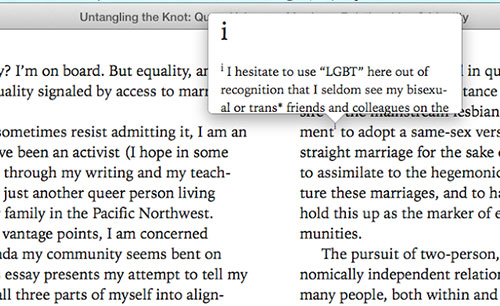In an Ooligan blog post last fall, I talked a little about how working with Untangling the Knot: Queer Voices on Marriage, Relationships & Identity has been a welcome challenge for the editing department. Working with a nonfiction anthology provides a host of new demands for editors—creating cohesiveness without sacrificing individuality, speaking consistently toward a theme, and maintaining grammatical uniformity—but ultimately, it’s not just editors that get to flex their publishing muscles. This quarter, we’re dealing with the digital design of the book, which involves a lot of stylistic and logistic choices in ebook functionality for a group of students that doesn’t necessarily have a lot of experience in that department.
The publishing industry is changing rapidly right now—it’s not at the same place it was even a short year ago—and the digital book market’s advancement is one of the largest factors in this forward momentum. Ooligan’s ever-changing staff of student workers and constant influx of new blood means it has, by nature, a benefit that other publishing houses might not. We get to experiment—in particular with this new digital wonderland, which constantly makes us reevaluate the way we display information. Obviously, for a book like Untangling the Knot—a book for which we have so carefully considered the way the material is edited, ordered, designed, displayed, and presented for a physical format—we wouldn’t want to do the text the disservice of a flat, static ebook.
An ebook’s dynamism is what distinguishes it as a format. Though the design limitations of an ebook are significant, what an ebook lacks in style, it makes up for in accessibility and interactivity. This isn’t a huge concern for a fiction piece, but a piece of nonfiction with footnotes and an index is ripe for experimentation. We struggled with the age-old question of footnote versus endnote for Untangling the Knot when we were first visualizing the design. An endnote could go at the end of an essay or the end of a book, and a footnote could go at the bottom of a page. Footnotes are easier to access and read; endnotes look more approachable to a casual audience. These are the limitations of a physical page, but they don’t exist in a digital format. For the physical design of the book, we went with endnotes at the close of each chapter so as to make them as readable as possible without alienating our demographic, though this is still not ideal.
The most widely used ebook file format is called EPUB and is used across almost all ereader platforms except for Amazon’s Kindle, which uses another format called MOBI. A few years ago, EPUB3 overtook its earlier counterpart EPUB2 and brought with it a whole new host of capabilities, most notably its increased compatibility with HTML functions. This includes the introduction of the aside element, which essentially allows for little pop-ups on the screen of the ereader to appear over the text in an easy-to-read bubble. This means a publisher doesn’t have to decide what to do with a footnote or an endnote, doesn’t have to sacrifice one demographic for another, and can make these notes both approachable for those who want to read them and discreet for those who don’t. An earlier format afforded the opportunity to link footnotes and endnotes from where they existed on a page to their source, but that’s ultimately the digital equivalent of flipping a page and strangely adherent to the physical limitations that a paper copy of a book might present. The further we move away from this base format, the closer we come to realizing the true potential of the digital one.
Implementation of these elements requires a fairly cursory knowledge of ebooks and EPUB formats, typecoding, and HTML, but the best part about these technologies becoming more approachable and widely used is that the platform’s capabilities are standardizing. They’re becoming easier to implement while simultaneously becoming more responsive, sensitive, and design-oriented. If you’d like to try out a different and potentially more user-friendly experience, why not purchase the ebook for Untangling the Knot and give it a read?

